| Language version: | ActionScript 3.0
|
The Matrix class represents a transformation matrix that determines how to map points from one
coordinate space to another. You can perform various graphical
transformations on a display object by setting the properties of a Matrix object,
applying that Matrix object to the
matrix property of a Transform object,
and then applying that Transform object as the
transform property of the display object.
These transformation functions include translation
(
x and
y repositioning), rotation, scaling, and skewing.
Together these types of transformations are known as affine transformations.
Affine transformations preserve the straightness of lines while transforming, so that
parallel lines stay parallel.
To apply a transformation matrix to a display object, you create a Transform
object, set its matrix property to the transformation matrix, and then set the transform
property of the display object to the Transform object.
Matrix objects are also used as parameters of some methods, such as the following:
- The
draw() method of a BitmapData object
- The
beginBitmapFill() method, beginGradientFill() method,
or lineGradientStyle() method of a Graphics object
A transformation matrix object is a 3 x 3 matrix with the following contents:
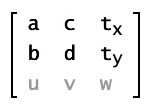
In traditional transformation matrixes, the u, v, and w
properties provide extra capabilities.
The Matrix class can only operate in two-dimensional space, so it always
assumes that the property values u and v are 0.0, and that the property value
w is 1.0. The effective values of the matrix are as follows:
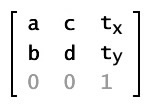
You can get and set the values of all six of the other properties in a Matrix
object: a, b, c,
d, tx, and ty.
The Matrix class supports the four major types of transformations:
translation, scaling, rotation, and skewing. You can set three of these transformations by using
specialized methods, as described in the following table:
| Transformation |
Method |
Matrix values |
Display result |
Description |
| Translation (displacement) |
translate(tx, ty) |
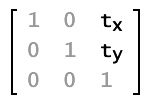 |
 |
Moves the image tx pixels to the right and ty pixels
down. |
| Scaling |
scale(sx, sy) |
 |
 |
Resizes the image, multiplying the location of each pixel by sx on the
x axis and sy on the y axis. |
| Rotation |
rotate(q) |
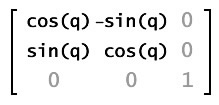 |
 |
Rotates the image by an angle q, which is measured in radians. |
| Skewing or shearing |
None; must set the properties b and c |
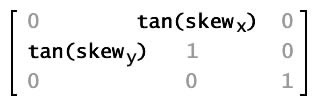 |
 |
Progressively slides the image in a direction parallel to the x or y axis. The b
property of the Matrix object represents the tangent of the skew angle along the y axis;
the c property of the Matrix object represents the tangent of the skew angle along the
x axis. |
Each transformation function alters the current matrix properties so that
you can effectively combine multiple transformations. To do this, you call more than one
transformation function before applying the matrix to its display object target (by using the
transform property of that display object).
Use the new Matrix() constructor to create a
Matrix object before you can call the methods of the Matrix object.
View the examples.
public var a:Number
| Language version: | ActionScript 3.0
|
The value that affects the positioning of pixels
along the x axis when scaling or rotating an image.
Example
The following example creates the Matrix object
myMatrix and sets its
a value.
import flash.geom.Matrix;
var myMatrix:Matrix = new Matrix();
trace(myMatrix.a); // 1
myMatrix.a = 2;
trace(myMatrix.a); // 2
public var b:Number
| Language version: | ActionScript 3.0
|
The value that affects the positioning of pixels
along the y axis when rotating or skewing an image.
Example
The following example creates the Matrix object
myMatrix and sets its
b value.
import flash.geom.Matrix;
var myMatrix:Matrix = new Matrix();
trace(myMatrix.b); // 0
var degrees:Number = 30;
var radians:Number = (degrees/180) ~~ Math.PI;
myMatrix.b = Math.tan(radians);
trace(myMatrix.b); // 0.5773502691896257
public var c:Number
| Language version: | ActionScript 3.0
|
The value that affects the positioning of pixels
along the x axis when rotating or skewing an image.
Example
The following example creates the Matrix object
myMatrix and sets its
c value.
import flash.geom.Matrix;
var myMatrix:Matrix = new Matrix();
trace(myMatrix.c); // 0
var degrees:Number = 30;
var radians:Number = (degrees/180) ~~ Math.PI;
myMatrix.c = Math.tan(radians);
trace(myMatrix.c); // 0.5773502691896257
public var d:Number
| Language version: | ActionScript 3.0
|
The value that affects the positioning of pixels
along the y axis when scaling or rotating an image.
Example
The following example creates the Matrix object
myMatrix and sets its
d value.
import flash.geom.Matrix;
var myMatrix:Matrix = new Matrix();
trace(myMatrix.d); // 1
myMatrix.d = 2;
trace(myMatrix.d); // 2
public var tx:Number
| Language version: | ActionScript 3.0
|
The distance by which to translate each point along the x axis.
Example
The following example creates the Matrix object
myMatrix and sets its
tx value.
import flash.geom.Matrix;
var myMatrix:Matrix = new Matrix();
trace(myMatrix.tx); // 0
myMatrix.tx = 50; // 50
trace(myMatrix.tx);
public var ty:Number
| Language version: | ActionScript 3.0
|
The distance by which to translate each point along the y axis.
Example
The following example creates the Matrix object
myMatrix and sets its
ty value.
import flash.geom.Matrix;
var myMatrix:Matrix = new Matrix();
trace(myMatrix.ty); // 0
myMatrix.ty = 50;
trace(myMatrix.ty); // 50
public function Matrix(a:Number = 1, b:Number = 0, c:Number = 0, d:Number = 1, tx:Number = 0, ty:Number = 0)
| Language version: | ActionScript 3.0
|
Creates a new Matrix object with the specified parameters. In matrix notation, the properties
are organized like this:

If you do not provide any parameters to the new Matrix() constructor, it creates an
identity matrix with the following values:
a = 1 |
b = 0 |
c = 0 |
d = 1 |
tx = 0 |
ty = 0 |
In matrix notation, the identity matrix looks like this:

Parameters
| a:Number (default = 1) |
| |
| b:Number (default = 0) |
| |
| c:Number (default = 0) |
| |
| d:Number (default = 1) |
| |
| tx:Number (default = 0) |
| |
| ty:Number (default = 0) |
Example
The following example creates
matrix_1 by sending no parameters to the
Matrix() constructor and
matrix_2 by sending parameters to it. Notice that
matrix_1, which was created with no parameters, results in an identity matrix with the values
a=1,
b=0,
c=0,
d=1,
tx=0,
ty=0.
import flash.geom.Matrix;
var matrix_1:Matrix = new Matrix();
trace(matrix_1); // (a=1, b=0, c=0, d=1, tx=0, ty=0)
var matrix_2:Matrix = new Matrix(1, 2, 3, 4, 5, 6);
trace(matrix_2); // (a=1, b=2, c=3, d=4, tx=5, ty=6)
public function clone():Matrix
| Language version: | ActionScript 3.0
|
Returns a new Matrix object that is a clone of this
matrix, with an exact copy of the contained object.
Returns
public function concat(m:Matrix):void
| Language version: | ActionScript 3.0
|
Concatenates a matrix with the current matrix, effectively combining the
geometric effects of the two. In mathematical terms, concatenating two matrixes
is the same as combining them using matrix multiplication.
For example, if matrix m1 scales an object by a factor of four, and
matrix m2 rotates an object by 1.5707963267949 radians
(Math.PI/2), then m1.concat(m2) transforms m1
into a matrix that scales an object by a factor of four and rotates the object by
Math.PI/2 radians.
This method replaces the source matrix with the concatenated matrix. If you
want to concatenate two matrixes without altering either of the two source matrixes,
first copy the source matrix by using the clone() method, as shown in the Class Examples section.
Parameters
| m:Matrix — The matrix to be concatenated to the source matrix.
|
public function copyColumnFrom(column:uint, vector3D:Vector3D):void
| Language version: | ActionScript 3.0
|
Copies a Vector3D object into specific column of the calling Matrix3D object.
Parameters
| column:uint — The column from which to copy the data from.
|
| |
| vector3D:Vector3D — The Vector3D object from which to copy the data.
|
public function copyColumnTo(column:uint, vector3D:Vector3D):void
| Language version: | ActionScript 3.0
|
Copies specific column of the calling Matrix object into the Vector3D object.
The w element of the Vector3D object will not be changed.
Parameters
| column:uint — The column from which to copy the data from.
|
| |
| vector3D:Vector3D — The Vector3D object from which to copy the data.
|
public function copyFrom(sourceMatrix:Matrix):void
| Language version: | ActionScript 3.0
|
Copies all of the matrix data from the source Point object into the
calling Matrix object.
Parameters
| sourceMatrix:Matrix — The Matrix object from which to copy the data.
|
public function copyRowFrom(row:uint, vector3D:Vector3D):void
| Language version: | ActionScript 3.0
|
Copies a Vector3D object into specific row of the calling Matrix object.
Parameters
| row:uint — The row from which to copy the data from.
|
| |
| vector3D:Vector3D — The Vector3D object from which to copy the data.
|
public function copyRowTo(row:uint, vector3D:Vector3D):void
| Language version: | ActionScript 3.0
|
Copies specific row of the calling Matrix object into the Vector3D object.
The w element of the Vector3D object will not be changed.
Parameters
| row:uint — The row from which to copy the data from.
|
| |
| vector3D:Vector3D — The Vector3D object from which to copy the data.
|
public function createBox(scaleX:Number, scaleY:Number, rotation:Number = 0, tx:Number = 0, ty:Number = 0):void
| Language version: | ActionScript 3.0
|
Includes parameters for scaling,
rotation, and translation. When applied to a matrix it sets the matrix's values
based on those parameters.
Using the createBox() method lets you obtain the same matrix as you would if
you applied the identity(), rotate(), scale(), and translate() methods
in succession. For example, mat1.createBox(2,2,Math.PI/4, 100, 100) has the
same effect as the following:
import flash.geom.Matrix;
var mat1:Matrix = new Matrix();
mat1.identity();
mat1.rotate(Math.PI/4);
mat1.scale(2,2);
mat1.translate(10,20);
var mat1 = new air.Matrix();
mat1.identity();
mat1.rotate(Math.PI/4);
mat1.scale(2, 2);
mat1.translate(10, 20);
| scaleX:Number — The factor by which to scale horizontally.
|
| |
| scaleY:Number — The factor by which scale vertically.
|
| |
| rotation:Number (default = 0) |
| |
| tx:Number (default = 0) |
| |
| ty:Number (default = 0) |
See also
Example
The following example sets the x scale, y scale, rotation, x location,
and y location of
myMatrix by calling its
createBox() method.
package
{
import flash.display.Shape;
import flash.display.Sprite;
import flash.geom.Matrix;
import flash.geom.Transform;
public class Matrix_createBox extends Sprite
{
public function Matrix_createBox()
{
var myMatrix:Matrix = new Matrix();
trace(myMatrix.toString()); // (a=1, b=0, c=0, d=1, tx=0, ty=0)
myMatrix.createBox(1, 2, Math.PI/4, 50, 100);
trace(myMatrix.toString());
// (a=0.7071067811865476, b=1.414213562373095, c=-0.7071067811865475,
// d=1.4142135623730951, tx=50, ty=100)
var rectangleShape:Shape = createRectangle(20, 80, 0xFF0000);
addChild(rectangleShape);
var rectangleTrans:Transform = new Transform(rectangleShape);
rectangleTrans.matrix = myMatrix;
}
public function createRectangle(w:Number, h:Number, color:Number):Shape
{
var rect:Shape = new Shape();
rect.graphics.beginFill(color);
rect.graphics.drawRect(0, 0, w, h);
addChild(rect);
return rect;
}
}
}
public function createGradientBox(width:Number, height:Number, rotation:Number = 0, tx:Number = 0, ty:Number = 0):void
| Language version: | ActionScript 3.0
|
Creates the specific style of matrix expected by the beginGradientFill() and
lineGradientStyle() methods of the Graphics class. Width and height are scaled to
a scaleX/scaleY pair and the tx/ty
values are offset by half the width and height.
For example, consider a gradient with the following characteristics:
GradientType.LINEAR- Two colors, green and blue, with the ratios array set to
[0, 255]
SpreadMethod.PADInterpolationMethod.LINEAR_RGB
The following illustrations show gradients in which the matrix was defined using the
createGradientBox() method with different parameter settings:
createGradientBox() settings |
Resulting gradient |
width = 25;
height = 25;
rotation = 0;
tx = 0;
ty = 0; |
 |
width = 25;
height = 25;
rotation = 0;
tx = 25;
ty = 0; |
 |
width = 50;
height = 50;
rotation = 0;
tx = 0;
ty = 0; |
 |
width = 50;
height = 50;
rotation = Math.PI / 4; // 45 degrees
tx = 0;
ty = 0; |
 |
Parameters
| width:Number — The width of the gradient box.
|
| |
| height:Number — The height of the gradient box.
|
| |
| rotation:Number (default = 0) |
| |
| tx:Number (default = 0)width parameter.
|
| |
| ty:Number (default = 0)height parameter.
|
See also
Example
The following example sets the x scale, y scale, rotation, x location,
and y location of
myMatrix by calling its
createBox() method.
package
{
import flash.display.GradientType;
import flash.display.Sprite;
import flash.geom.Matrix;
public class Matrix_createGradientBox extends Sprite
{
public function Matrix_createGradientBox()
{
var myMatrix:Matrix = new Matrix();
trace(myMatrix.toString()); // (a=1, b=0, c=0, d=1, tx=0, ty=0)
myMatrix.createGradientBox(200, 200, 0, 50, 50);
trace(myMatrix.toString()); // (a=0.1220703125, b=0, c=0, d=0.1220703125, tx=150, ty=150)
var colors:Array = [0xFF0000, 0x0000FF];
var alphas:Array = [100, 100];
var ratios:Array = [0, 0xFF];
this.graphics.beginGradientFill(GradientType.LINEAR, colors, alphas, ratios, myMatrix);
this.graphics.drawRect(0, 0, 300, 200);
}
}
}
public function deltaTransformPoint(point:Point):Point
| Language version: | ActionScript 3.0
|
Given a point in the pretransform coordinate space, returns the coordinates of
that point after the transformation occurs. Unlike the standard transformation applied using
the transformPoint() method, the deltaTransformPoint() method's
transformation does not consider the translation parameters tx and ty.
Parameters
| point:Point — The point for which you want to get the result of the matrix transformation.
|
Returns
| Point —
The point resulting from applying the matrix transformation.
|
public function deltaTransformPointToOutput(point:Point, output:Point):Point
| Language version: | ActionScript 3.0
|
| Runtime version: | AIR 33.1
|
Given a point in the pretransform coordinate space, returns the coordinates of
that point after the transformation occurs. Unlike the standard transformation applied using
the transformPoint() method, the deltaTransformPoint() method's
transformation does not consider the translation parameters tx and ty.
Parameters
| point:Point — The point for which you want to get the result of the matrix transformation.
|
| |
| output:Point — An optional point to be set with the output value and returned, to avoid the runtime creating a new point object.
|
Returns
| Point —
The point resulting from applying the matrix transformation.
|
public function identity():void
| Language version: | ActionScript 3.0
|
Sets each matrix property to a value that causes a null transformation. An object transformed
by applying an identity matrix will be identical to the original.
After calling the identity() method, the resulting matrix has the following properties:
a=1, b=0, c=0, d=1, tx=0, ty=0.
In matrix notation, the identity matrix looks like this:

public function invert():void
| Language version: | ActionScript 3.0
|
Performs the opposite transformation
of the original matrix. You can apply an inverted matrix to an object to undo the transformation
performed when applying the original matrix.
Example
The following example creates a
halfScaleMatrix by calling the
invert() method of
doubleScaleMatrix. It then demonstrates that
the two are Matrix inverses of one another -- matrices that undo any
transformations performed by the other -- by creating
originalAndInverseMatrix
which is equal to
noScaleMatrix.
package
{
import flash.display.Shape;
import flash.display.Sprite;
import flash.geom.Matrix;
import flash.geom.Transform;
public class Matrix_invert extends Sprite
{
public function Matrix_invert()
{
var rect0:Shape = createRectangle(20, 80, 0xFF0000);
var rect1:Shape = createRectangle(20, 80, 0x00FF00);
var rect2:Shape = createRectangle(20, 80, 0x0000FF);
var rect3:Shape = createRectangle(20, 80, 0x000000);
var trans0:Transform = new Transform(rect0);
var trans1:Transform = new Transform(rect1);
var trans2:Transform = new Transform(rect2);
var trans3:Transform = new Transform(rect3);
var doubleScaleMatrix:Matrix = new Matrix(2, 0, 0, 2, 0, 0);
trans0.matrix = doubleScaleMatrix;
trace(doubleScaleMatrix.toString()); // (a=2, b=0, c=0, d=2, tx=0, ty=0)
var noScaleMatrix:Matrix = new Matrix(1, 0, 0, 1, 0, 0);
trans1.matrix = noScaleMatrix;
rect1.x = 50;
trace(noScaleMatrix.toString()); // (a=1, b=0, c=0, d=1, tx=0, ty=0)
var halfScaleMatrix:Matrix = doubleScaleMatrix.clone();
halfScaleMatrix.invert();
trans2.matrix = halfScaleMatrix;
rect2.x = 100;
trace(halfScaleMatrix.toString()); // (a=0.5, b=0, c=0, d=0.5, tx=0, ty=0)
var originalAndInverseMatrix:Matrix = doubleScaleMatrix.clone();
originalAndInverseMatrix.concat(halfScaleMatrix);
trans3.matrix = originalAndInverseMatrix;
rect3.x = 150;
trace(originalAndInverseMatrix.toString()); // (a=1, b=0, c=0, d=1, tx=0, ty=0)
}
public function createRectangle(w:Number, h:Number, color:Number):Shape
{
var rect:Shape = new Shape();
rect.graphics.beginFill(color);
rect.graphics.drawRect(0, 0, w, h);
addChild(rect);
return rect;
}
}
}
public function rotate(angle:Number):void
| Language version: | ActionScript 3.0
|
Applies a rotation transformation to the Matrix object.
The rotate() method alters the a, b, c,
and d properties of the Matrix object.
In matrix notation, this is the same as concatenating the current matrix with the following:

Parameters
| angle:Number — The rotation angle in radians.
|
public function scale(sx:Number, sy:Number):void
| Language version: | ActionScript 3.0
|
Applies a scaling transformation to the matrix. The x axis is multiplied
by sx, and the y axis it is multiplied by sy.
The scale() method alters the a and d properties of
the Matrix object.
In matrix notation, this is the same as concatenating the current matrix with the following matrix:

Parameters
| sx:Number — A multiplier used to scale the object along the x axis.
|
| |
| sy:Number — A multiplier used to scale the object along the y axis.
|
public function setTo(aa:Number, ba:Number, ca:Number, da:Number, txa:Number, tya:Number):void
| Language version: | ActionScript 3.0
|
Sets the members of Matrix to the specified values
Parameters
public function toString():String
| Language version: | ActionScript 3.0
|
Returns a text value listing the properties of the Matrix object.
Returns
| String —
A string containing the values of the properties of the Matrix object: a, b, c,
d, tx, and ty.
|
public function transformPoint(point:Point):Point
| Language version: | ActionScript 3.0
|
Returns the result of applying the geometric transformation represented by the Matrix object to the
specified point.
Parameters
| point:Point — The point for which you want to get the result of the Matrix transformation.
|
Returns
| Point —
The point resulting from applying the Matrix transformation.
|
public function transformPointToOutput(point:Point, output:Point):Point
| Language version: | ActionScript 3.0
|
| Runtime version: | AIR 33.1
|
Returns the result of applying the geometric transformation represented by the Matrix object to the
specified point.
Parameters
| point:Point — The point for which you want to get the result of the Matrix transformation.
|
| |
| output:Point — An optional point to be set with the output value and returned, to avoid the runtime creating a new point object.
|
Returns
| Point —
The point resulting from applying the Matrix transformation.
|
public function translate(dx:Number, dy:Number):void
| Language version: | ActionScript 3.0
|
Translates the matrix along the x and y axes, as specified by the dx
and dy parameters.
Parameters
| dx:Number — The amount of movement along the x axis to the right, in pixels.
|
| |
| dy:Number — The amount of movement down along the y axis, in pixels.
|
The following example uses the
MatrixExample class to show
how a large gradient-filled square can be created. This is accomplished with the following
steps:
- The application creates a new Matrix object
myMatrix, and it uses the
trace() method to output
the default property values for the myMatrix object.
- The application calls the
createGradientBox() with the width
and height parameters set to 200 pixels, no rotation, and the distance to translate along
the x and y axes set to 50 pixels.
- The application prints the
myMatrix object again to show the change after calling
createGradientBox().
- The application sets up three variables to control how the gradient box is filled:
colors: Sets the gradient colors to range between solid red and solid blue.alphas: Sets the opacity to solid.ratios: Sets the distribution of the colors to be equal for both red and blue.
- The application calls the graphics method
beginGradientFill(), which operates on the myMatrix
object, and it calls the lineTo() method, resulting in the gradient-filled box.
package {
import flash.geom.Matrix;
import flash.display.Sprite;
import flash.display.GradientType;
public class MatrixExample extends Sprite {
public function MatrixExample() {
var myMatrix:Matrix = new Matrix();
trace(myMatrix.toString()); // (a=1, b=0, c=0, d=1, tx=0, ty=0)
myMatrix.createGradientBox(200, 200, 0, 50, 50);
trace(myMatrix.toString()); // (a=0.1220703125, b=0, c=0, d=0.1220703125, tx=150, ty=150)
var colors:Array = [0xFF0000, 0x0000FF];
var alphas:Array = [1, 1];
var ratios:Array = [0, 0xFF];
graphics.beginGradientFill(GradientType.LINEAR, colors, alphas, ratios, myMatrix);
graphics.lineTo(0, 300);
graphics.lineTo(300, 300);
graphics.lineTo(300, 0);
graphics.lineTo(0, 0);
}
}
}
© 2004-2022 Adobe Systems Incorporated. All rights reserved.
Thu Feb 27 2025, 6:06 AM GMT


 Object
Object


























